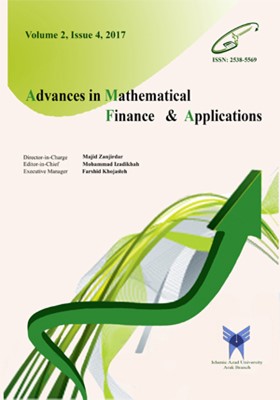Using Genetic Algorithm in Solving Stochastic Programming for Multi-Objective Portfolio Selection in Tehran Stock Exchange
محورهای موضوعی : Financial MathematicsSeyed Alireza Miryekemami 1 , Ehsan Sadeh 2 , Zeinolabedin Sabegh 3
1 - Department of Industrial management, Science and Research Branch, Islamic Azad University, Tehran, Iran
2 - Department of Management, Saveh Branch, Islamic Azad University, Saveh, Iran
3 - Department of Management, Saveh Branch, Islamic Azad University, Saveh, Iran
کلید واژه: Genetic Algorithm, Portfolio optimization, Multi criteria decision making Stochastic Programming, Chance constrained compromise,
چکیده مقاله :
Investor decision making has always been affected by two factors: risk and returns. Considering risk, the investor expects an acceptable return on the investment decision horizon. Accordingly, defining goals and constraints for each investor can have unique prioritization. This paper develops several approaches to multi criteria portfolio optimization. The maximization of stock returns, the power of liquidity of selected stocks and the acceptance of risk to market risk are set as objectives of the problem. In order to solve the problem of information in the Tehran Stock Exchange in 2017, 45 sample stocks have been identified and, with the assumption of normalization of goals, a genetic algorithm has been used. The results show that the selected model provides a good performance for selecting the optimal portfolio for investors with specific goals and constraints.
[1] H. Markowitz, Portfolio selection, J. Finance, 1952, 7, P.77–91.
[2] Sharpe W. F., Capital asset prices: A theory of market equilibrium under conditions of risk. The Journal of Finance, 1964, 19(3), P.425-442.
[3] Ross. S. A., The arbitrage theory of capital asset pricing. Journal of Economic Theory,1976, 13(3), P.341-360.
[4] Modigliani F., Merton H. Miller. The cost of capital, corporation finance and the theory of investment. The American Economic Review, 1958, 48(3), P.261-297.
[5] Nawrocki, D.N., Carter, W.L. Earnings announcements and portfolio selection. Do they add value? International Review of Financial Analysis, 1998, 7, P.37–50.
[6] Bell, D. E., Raiffa, H., & Tversky, A. (Eds.). Decision making: Descriptive, normative, and prescriptive interactions. Cambridge University Press, 1988, 12, P.99–112.
[7] Ballestero, E., Romero, C. Portfolio selection: A compromise programming solution. Journal of the Operational Research Society, 1996, 47, P.1377-1386.
[8] Lee, S.M., Chesser, D.L., Goal Programming for Portfolio Selection, the Journal of Portfolio Management, 1980,13, P.22–26.
[9] Zeleny, M., Multiple Criteria Decision Making. McGraw-Hill, New York,1982.
[10] Abdelaziz, F.B., Lang, P., & Nadeau, R. Distributional efficiency in multi objective stochastic linear programming, European Journal of Operational Research, 1995, 85(2), P.399-415.
[11] Abdelaziz, F.B., Lang, P., Nadeau, R. Efficiency in multiple criteria under uncertainty. Theory and Decision, 1999, 47, P.191–211.
[12] Abdelaziz, F. B., Aouni B., Rimeh El Fayedh, Multi-objective stochastic programming for portfolio selection. European Journal of Operational Research, 2007, 177, P.1811–1823.
[13] Abdelaziz, F. B., Solution approaches for the multi objective stochastic programming. European Journal of Operations Research, 2012, 216, P.1–16.
[14] Sarr, A., Lybek T., Measuring Liquidity in Financial Markets, IMF Working Paper WP/02/232, International Monetary Fund, 2002.
[15] Holland, J. H. Adaptation in natural and artificial systems: an introductory analysis with applications to biology, control and artificial intelligence. University of Michigan Press, 1975.
[16] Goldberg, D. E. Genetic algorithms in search, optimization and machine learning. New York: Addison-Wesley, 1989.
[17] Wong, F., Tan, C., Hybrid neural, genetic, and fuzzy systems. In G. J. Deboeck (Ed.), Trading on the edge New York: Wiley, 1994, 45, P.243–261.
[18] Adeli, H., Hung, S., Machine learning: neural networks, genetic algorithms, and fuzzy systems. New York: Wiley, 1995.
[19] Orito, Y., Yamamoto, H., Yamazaki, G., Index fund selections with genetic algorithms and heuristic classifications. Computers and Industrial Engineering, 2003, 45, P.97–109.
[20] Xia, Y., Liu, B., Wang, S., Lai, K. K., A model for portfolio selection with order of expected returns. Computers and Operations Research, 2000, 27, P.409–422.
[21] T. Li, W.G. Zhang, W. J. Xu, A fuzzy portfolio selection model with background risk, Appl. Math. Comput., 2015, 256, P.505-513.
[22] Cheong D., Kim Y., Byun H., Kyong Joo Oh, Kim T., Using genetic algorithm to support clustering-based portfolio optimization by investor information, Original Research Article., Applied Soft Computing, 2017, 61, P.593-602
[23] Kalayci C., Ertenlice O., Akyer H., Aygoren H., An artificial bee colony algorithm with feasibility enforcement and infeasibility toleration procedures for cardinality constrained portfolio optimization, Original Research Article, Expert Systems with Applications, 2017, 85(1), P.61-75.
[24] Suraj S. Meghwani, M.Th., Multi-objective heuristic algorithms for practical portfolio optimization and rebalancing with transaction cost, Original Research Article Applied Soft Computing, In Press, Corrected Proof, 2017.
[25] Kumar D., Mishra K.K., Portfolio optimization using novel co-variance guided Artificial Bee Colony Algorithm Original Research Article, Swarm and Evolutionary Computation, 2017, 33, P.119-130.
[26] Levy, F., Richard J. M., US earnings levels and earnings inequality: A review of recent trends and proposed explanations. Journal of economic literature, 1992, 30(30), P.1333-1381.


